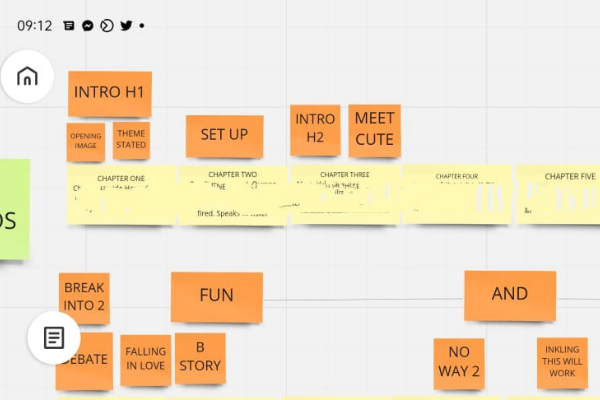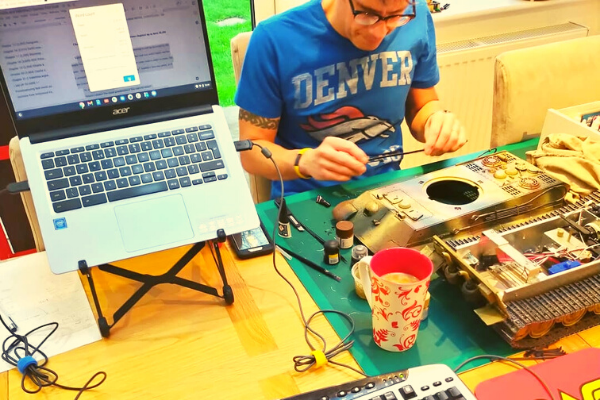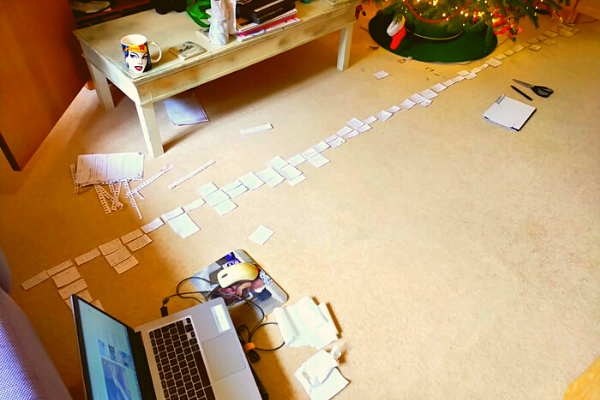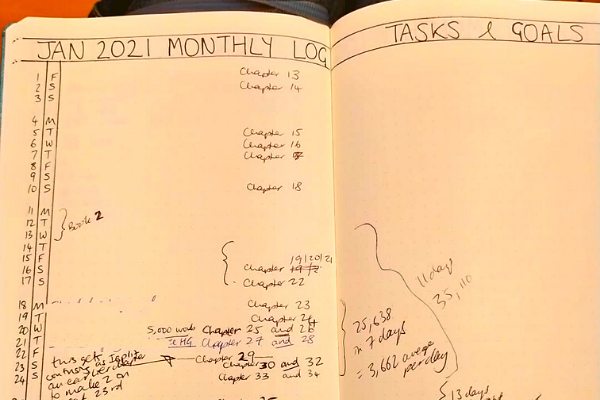
How to Write the First Draft of a Book
Every writer has their process, their way of getting from an idea in their head to words on a page. The first draft is one of the biggest milestones in the publishing process and I wanted to share how I got to the first draft of book three in the Kinloch series.
Our hero and heroine are Charlie and Valentina. Charlie is the best mate of Rory, our hero in Highland and Hollywood Games. Valentina is a movie star. We meet them briefly in Hollywood Games, and I saw an opportunity to explore their relationship in their own, standalone story.
After I wrote the enormous draft that ended up being split into Highland and Hollywood Games, I swore I would never write a book (or two!) in the same way ever again. It was a nightmare, and I spent the best part of eighteen months splitting them. I did learn a huge amount in the process so the time wasn’t wasted, however it’s not something I ever wanted to repeat.
Plotting vs Pantsing a First Draft
In the writing world, people often describe themselves as plotters or pantsers. The plotter meticulously plans out the structure and character arcs of their book and only starts writing when it is mostly, if not totally, organised and ready to write. I dream of such things. The pantser is the person who sits down and just starts writing – flying by the seat of their pants. There are of course as many versions of each approach as there are writers, and advantages and disadvantages to each. I also believe that the more experienced a writer is, the more they can pants, as the inherent logic of story structure has become hardwired into their brain. I’m not there yet by any stretch of the imagination, but I did feel glimpses of this when I was writing book three.
So, starting out I had my two lead characters, but no idea of who they really were. I also had story points that each of them was involved with in Hollywood Games, that had to find their place in book three. At the time I thought this would make things easier, however that was not the case. In fact I ended up having to go back and change Hollywood Games based on what I ended up writing in this book.
I started work at the beginning of November 2020. I was determined to not only map out the character arcs for my leads, but to plan the shit out of the story, so I wasn’t left with a huge Act 1, too small an Act 2, and a hurried Act 3, which is what I spent over a year fixing on my first two books.
Laying the right foundations for a first draft

I started with a blank document entitled ‘Charlie & Valentina book ideas and outline’. At the top, I wrote:
Do this before writing a word! Have in place:
Title –
Tagline –
Hook (149 characters max) –
Short blurb (50 words max) –
Blurb (150 words max) –
Character descriptions and arcs –
Story beat outline (As specified by Saving the Cat Writes a Novel, and Romancing the Beat) –
Scene-by-scene outline –
Tropes used –
One page synopsis –
Oh, my plans were so grand… When I started writing, I had precisely ONE of those things in place, the trope of ‘Celebrity Fling’, which isn’t even accurate. Even now the first draft is done, I still don’t have any of these done. 😂😂😂 I could write character descriptions and arcs, as well as a scene by scene outline, but only because I’ve now written the bloody thing.
Discovering who your characters are

With all the right intentions, I then worked on describing Charlie and Valentina using the following criteria:
Name, age and physical description –
Emotional wounds –
Character wants and needs –
Role in story –
Birthday –
Beliefs –
Fears –
Goals –
Habits –
Another way to look at this is to ask the following questions of your characters:
What is their outer motivation? – a ‘want’ or a ‘goal’ for your character. How they think they will solve their problems?
What is their inner motivation? – a ‘need’ or a life lesson that is currently unmet?
What is their outer conflict? – what blocks the path to their goal?
What is their inner conflict? – dysfunctional behaviours and beliefs that get in their way – ‘you’re your own worst enemy’…
What is their ‘lie‘? – a personal misbelief that holds back your character or causes them to self-sabotage.
What is their ‘wound‘? – a past event that causes deep psychological trauma.
What is their fear? – that the same emotional pain will occur unless drastic measures are taken.
What is their resolution? – to achieve the goal that restores the missing need, the character must face the past, and gain perspective with regard to their wound, view themselves as worthy of a better future, reject the lie, and break down their emotional walls so they can embrace their inner strength and leave the flaw behind.
It’s also important to consider your character’s ‘theme’ – what they need to overcome their critical flaw and the life lesson they need to learn. Save The Cat Writes a Novel identifies ten fundamentals of: Forgiveness/ Love/ Acceptance/ Faith/ Fear/ Trust/ Survival/ Selflessness/ Responsibility/and Redemption.
The formula is: ‘If a character wants to <achieve inner goal> they need to stop being so <critical flaw> and learn <one of the fundamental lessons>. This is turn will help them achieve their <outer goal>.
I’ve just looked back at what I wrote in early November and cringed. It bears almost zero resemblance to the characters I ended up writing. So, another valiant attempt but ultimately a total fail.
Another way of skinning the character cat is to ask these questions:
Lack – what the character is missing at the start of the story, known or unknown to them
Longing – what can the character see/experience that would cause them to long to fulfill the above lack?
Fear – internal conflict: Once longing is realised, what fear will hold them back, preventing them from going after what they want?
Obstacle – external conflict: what prevents the character from getting what they want? How does this make them feel?
Ultimatum – what is the turning point where they are faced with getting what they want or giving it up forever? Which do they choose?
Second thoughts – after making the above decision, what causes them to rethink that choice? What could make them want to go back to the way things were, if they chose to get it, or go after it if they didn’t?
Resolve – doubts confronted one way or the other. What makes them reaffirm their choice?
Realisation – once the choice is affirmed, the character must realise something about themselves – possibly a negative belief, or their core flaw. What triggers this realisation?
Adaptation – final step – because of the realisation, the character must change in a fundamental way, how do they change; what do they become, what is their new belief?
Again, I just went back to look at what I originally wrote, and couldn’t read more than a few lines. It’s so different to the characters I ended up writing. Sooooooooo different.
I then wrote the words ‘scene ideas’ and jotted down any idea that came to mind after having written the wildly inaccurate character descriptions and arcs. I followed this with the actual scenes from Hollywood Games that they were involved in, as these were (so I thought at the time) set in stone.
Structuring the First Draft

Next up, filled with excitement about how differently I was approaching writing this book, I turned to story structure.
Very basic story structure contains three ‘acts’.
Act 1 – 25% – Thesis
Act 2 – 50% – Antithesis
Act 3 – 25% – Synthesis
At the end of Act 2 there is a plot point that turns the action on its head. Halfway through the story there is the midpoint which is another pivot point. In romance structure, this is usually the point that our leads become intimate. If they have already been having sex, then this often is the time the sex becomes more emotionally intimate. At the end of the second act, there is another plot point which pivots us into Act 3.
There are various different approaches and templates for story structure, but one of my favourites is from ‘Saving the Cat’. I took this template and put each moment onto a virtual sticky note on a virtual white board in Miro, and started to try and find a story to fit. I didn’t get very far… I had some ideas that could get me vaguely up to the midpoint, but after that I had nothing. I was trying to find a plot and rapidly losing my own.

At this point, my lovely author friend, Julia, told me in no uncertain terms that I had to just get on and start writing. I am extremely grateful to her for saying this as otherwise, I would never have started.
Starting to write the first draft
For me, the magic of my first draft unfolded as I started writing. I may have had an idea in my head of ‘Charlie and Valentina meet for the first time at an airport’, but when I started writing the scene, so much more came up about their personalities and backstory. This continued happening throughout the writing process. Not only that, but random things I was doing in my life prompted ideas that then became absolutely critical to the entire story.

Here is an example, without (hopefully) giving away any spoilers… One day I was writing at the dining table and wearing headphones to try and block out the noise of my family (I am aware I could have moved, but I like being around them). I went onto YouTube and started listening to a compilation of classical tunes. At the time, I was writing a scene where Charlie and Valentina are in a car, driving to the local town. I included the music I was listening to, and then wrote a throwaway line of dialogue. That throwaway line went on to become one of the biggest storylines in the book and gave me Charlie’s deepest emotional wound.
So, for me, even though I wanted to write book three as if I was merely ‘painting by numbers’, it didn’t turn out like that all. I actually ended up pantsing a lot of the book, accompanied by loose plotting.
Things were motoring along nicely until I was reaching the midpoint of the story. From then, I knew I had to hit certain story beats, but wasn’t sure exactly where they would go, or how the book would end. I took some time off, and went old school. I cut up pieces of paper, wrote scenes or moments on them, and laid them out on the living room floor. What you see in the picture above is the second half of the story. When I was happy that I had something that, in theory, would work, I wrote the scenes in one liners at the bottom of my manuscript and worked slowly through them. Things changed and got dropped, but I had my road map.

As I was writing, I would periodically go back to my whiteboard on Miro and fill in the sticky notes to describe the chapters I had written. I had written enough to know that Act 1 was 22,650 words. Based on doubling that, I expected Act 2 to be 45,300 words. I always tend to write slightly bigger Act 1’s, so when Act 2 came in, it was 42,858 words, which actually wasn’t far off.
I then split the length of Act 2 to give me a projected length of 21,429 words for Act 3. When writing Act 3, I felt my way through, not trying to stick to this, but just going where the story led me. When I had finished, it came in at 21,015 words, only four hundred words off being exactly half the length of Act 2. This was amazing. I couldn’t believe it, and was so happy that the lengths of the three acts were this close to perfection.
In terms of how long it took me to write the first draft of book three, I wrote the first chapter on the 20th November and finished Act 1 on the 4th December. I then had a massive crisis of confidence, and dropped everything until the 29th December. From then on, I only stopped to plan the second half of the book, and finish final edits of book two to send to my editor. I finished on the 26th January, 2021, having written a staggering fifty-nine thousand words with the month. It was absolutely exhausting and not a process I recommend, however it was what I did.

The first draft is only the beginning of the journey but I feel like a massive milestone has been reached. The plan now is to leave the manuscript for at least a couple of weeks to allow my brain a break. When I go back to it, I know there are things that need changing so I’ll make as many improvements as I can, then send it out to my beta readers. I’m hoping that it won’t take too long to get to the final draft with this manuscript as it’s (in my optimistic mind) already in good shape.
Let me know if this has been useful, and if you have any questions. You can get in touch via email or social media. I’ll also be posting updates on the editing process as I go along,
Evie X





